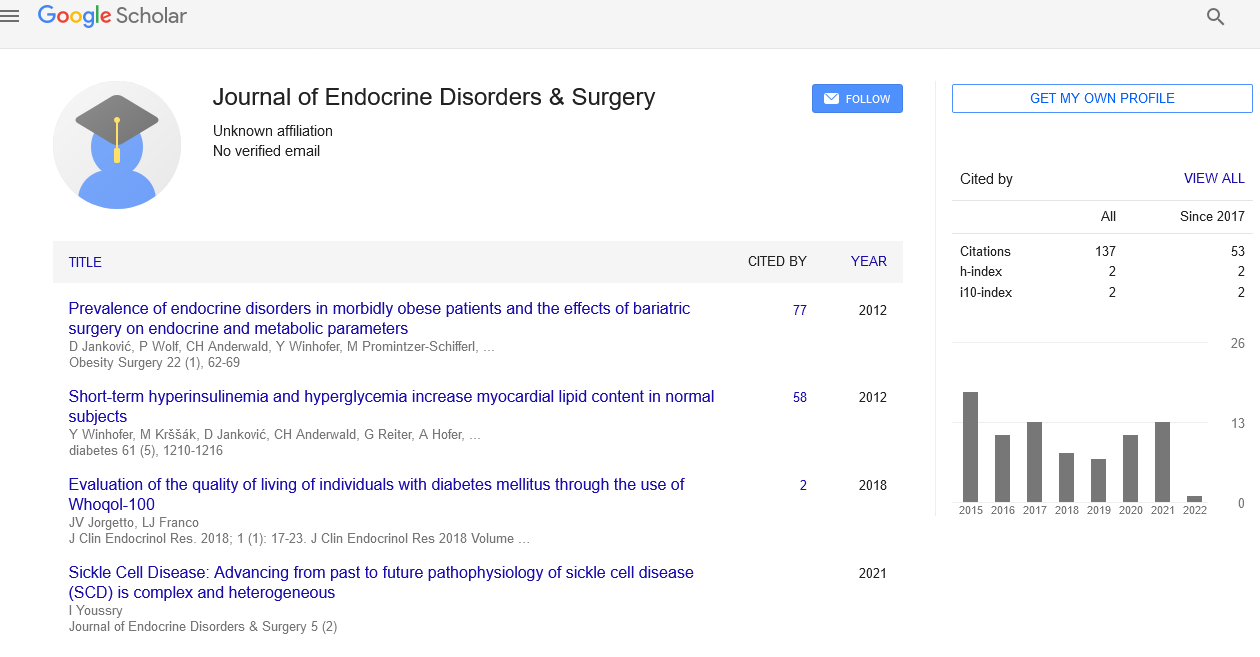Enteroendocrine cells
Received: 04-Oct-2022, Manuscript No. PULJEDS-23-6202 ; Editor assigned: 06-Oct-2022, Pre QC No. PULJEDS-23-6202 (PQ); Accepted Date: Oct 25, 2022; Reviewed: 10-Oct-2022 QC No. PULJEDS-23-6202 (Q); Revised: 12-Oct-2022, Manuscript No. PULJEDS-23-6202 (R); Published: 30-Oct-2022, DOI: 10.37532/puljds.2022.6(5).05
Citation: James A. Enteroendocrine cells. J. Endocr Disord Surg. 2022; 6(5):05.
This open-access article is distributed under the terms of the Creative Commons Attribution Non-Commercial License (CC BY-NC) (http://creativecommons.org/licenses/by-nc/4.0/), which permits reuse, distribution and reproduction of the article, provided that the original work is properly cited and the reuse is restricted to noncommercial purposes. For commercial reuse, contact reprints@pulsus.com
Abstract
Specialized cells called enteroendocrine cells can be located in the pancreas, stomach, and gastrointestinal tract. They respond to a variety of cues by producing and releasing hormones. The hormones may be dispersed as local messengers or they may be released into the bloodstream to produce systemic effects. Additionally, they might cause an anxious reaction. Despite making up only 1% of the intestinal mucosa, enteroendocrine cells are the most prevalent type of endocrine cell in the body. More than twenty peptides are produced by enteroendocrine cells in response to nutrients in the gut. The cells release a variety of peptide hormones that operate locally on nerve endings and cells in the intestinal lining depending on where they are in the gut. They also affect other systems in the body, like the pancreas.
Keywords
Pancreas; Hormones
Introduction
Enteroendocrine cells have historically been the subject of study to better understand their functions in promoting sufficient postprandial food and nutrient absorption and digestion. These cells' primary job is to detect nutrients in the intestine and create the best circumstances for nutrient absorption. case Specialized cells of the digestive system and pancreas with an endocrine role are called enteroendocrine cells. In response to various stimuli, they produce gastrointestinal hormones or peptides that are then released into the bloodstream for systemic effects, spread as local messengers, or are transmitted to the enteric nervous system to trigger nervous responses. The majority of the body's endocrine cells are found in the enteroendocrine cells of the gut. In the same way that the enteric nerve system is a subset of the nervous system, they make up an enteric endocrine system, which is a part of the endocrine system. They are known to function somewhat like chemoreceptors, starting digestive processes, sensing harmful substances, and starting defence mechanisms. The pancreas, gut, and stomach all contain enteroendocrine cells. These enteroendocrine cells intestinal immune and metabolic reactions are significantly influenced by the microbiota through the fermentation product (short chain fatty acid), acetate.
As they target various tissues involved in the regulation of intestinal function, insulin secretion, nutrient assimilation, and food consumption, gut hormones play a number of important functions in the regulation of metabolism. Gut hormones, which are produced by sporadic cells located along the intestinal epithelium, send messages about the rate of nutrient absorption, the make-up of the luminal milieu, and the strength of the epithelial barrier. The licenced glucagon-like peptide 1 (GLP1) mimetics and dipeptidyl peptidase inhibitors that enhance GLP1 receptor activation serve as examples of how gut hormones already serve as the foundation for existing and developing therapeutics for type 2 diabetes mellitus and obesity. An effective way to imitate bariatric surgery and its numerous positive effects on appetite, body weight, and blood sugar levels is by modifying the release of the endogenous stores of GLP1 and other gut hormones. This Review concentrates on the molecular processes that underlie how food intake, obesity, and the gut bacteria influence the release of gut hormones. Depending on the stimulus, different signaling pathways, such as G protein-coupled receptors, nutrient transporters, and ion channels are activated, leading to the release of gut hormones. These pathways are potential targets for diabetes mellitus and obesity treatments in the future. About 1% of the epithelium cells in the small intestine are enteroendocrine cells, which are dispersed throughout the organ. Enteroendocrine cells are designed for release, just like goblet cells and Paneth cells. They detect luminal contents, especially nutrients, and produce a variety of regulatory substances that control digestion, intestinal motility, and food consumption. These substances include gastric inhibitory peptide, glucagon-like peptide, and vasoactive intestinal peptide. Despite being dispersed throughout the gut, enteroendocrine cells make up one of the body's biggest endocrine systems when combined. Additionally, along the other words that which include the other words that which include the other words that which include the other words that which include the other people are discovered while again so encounter are discovered while again so encounter count EECs operate in a variety of ways, from local control of gut motility and secretion to the regulation of insulin release and food intake, by releasing gut hormones in response to meal-related stimuli. EECs are typically categorised based on the main hormone they generate. Serotonin, for example, is generated throughout the entire length of the gut and is crucial for motility. Over 90% of the body's serotonin is produced by enterochromaffin cells, an EEC subtype that has been linked to a number of pathophysiological and physiological conditions.





